Saraceno’s Floating Worlds
Camille LeFevre reflects on the airy, utopian constructions of architect Tomás Saraceno, a number of whose creations are on view this summer at the Walker Art Center.
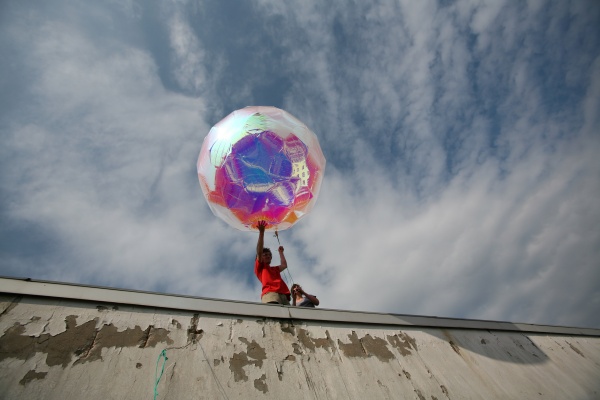
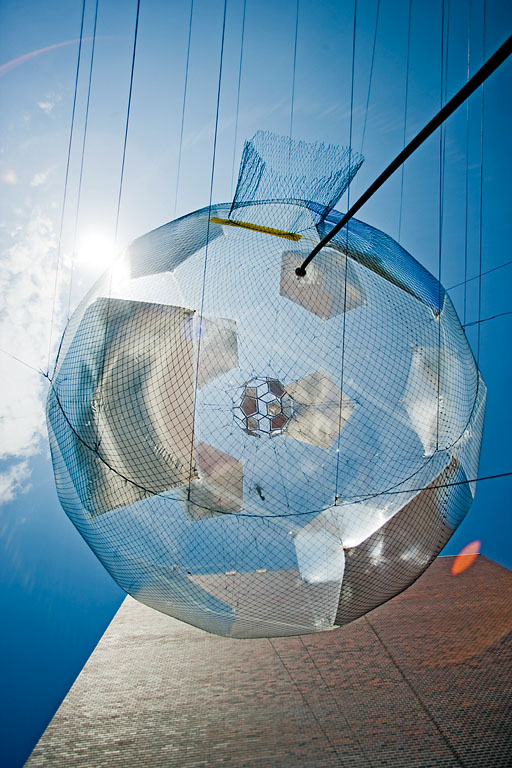

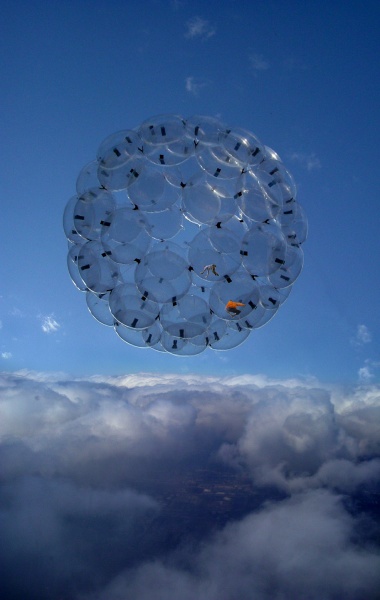
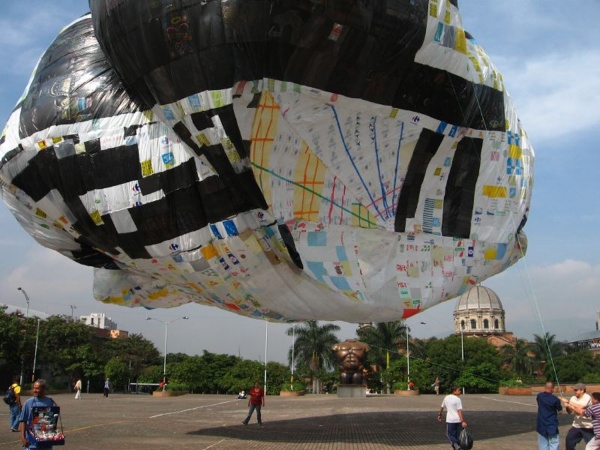
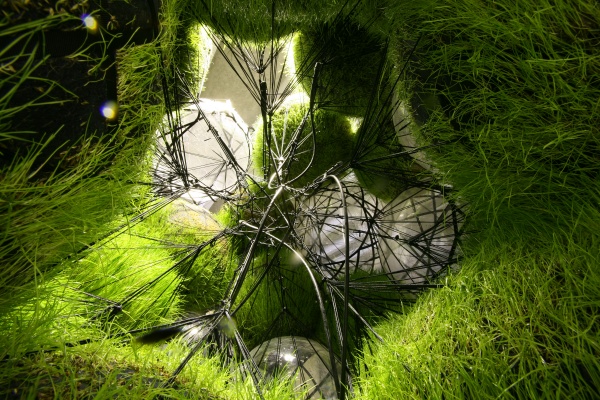
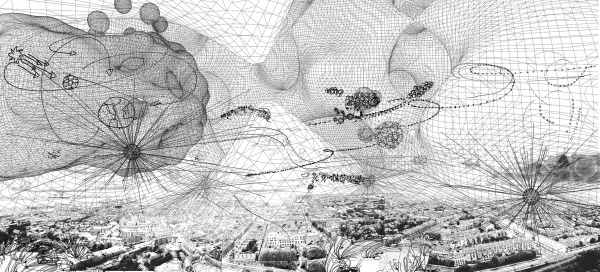
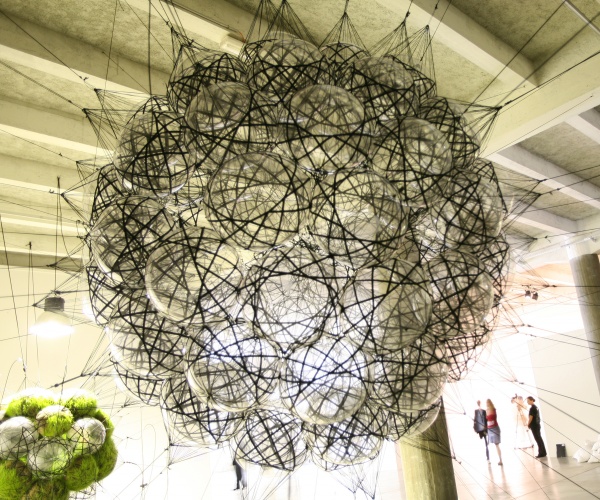
“COOL.” THAT WAS MY FIRST, SPONTANEOUS REACTION as I turned the corner in the Walker Art Center’s Medtronic Gallery and saw Tomás Saraceno’s 32SW Stay Green/Flying Garden/Air-Port-City. Next, I wanted to touch it. The work, tethered to the floor and ceiling by black elastic bands, is a giant globule of 30 plastic elliptical pillows — some clear, some covered with black felt from which long, fine hairs of grass are growing — hovering over a black-plastic lined pool, into which water from the sculpture slowly drips.
Occasionally, tiny sprayers (they’re reportedly solar powered) mist the sculpture (hence, the drips). According to Yasmil Raymond, visual arts curator, this construction and three similar “Air-Port-Cities” in the small show, Lighter than Air, are meant to be fantastical utopias that offer the imagination an escape from politics, boundaries, and economics-as-usual on planet Earth. Saraceno has described these utopias as “huge kinetic structures that work toward a real economic transformation” by allowing for “more elastic and dynamic border rules (political, geographical, etc.) for a new space/cyberspace.”
To which I must ask, “This is utopia?” Because, although these sculptures are beautiful, meditative and captivating, they emanate a sense of profound sadness. The structures are all surface, and a plastic surface at that. Nothing but air exists within the individual globes or pillows; and they’re arranged in a circular fashion leaving nothing but empty space — and an intersection of cables, sometimes supporting a light — in the middle. When I observe myself reflected in one of the clear plastic globes, I see a figure suspended in nothingness; it’s a philosophical treatise on existence, perhaps, but also a comment on our isolation in the midst of “community.”
The sculptures have a disturbingly sci-fi quality (OK, stop smirking. I know who you are). Trekkies will find that the sculptures look distinctly Borg-like with their silent, indifferent, gorgeously oppressive repetition of a single individual form. The aforementioned 32SW Stay Green, a living sculpture hooked up to water and power, resembles a trapped alien creature on life-support. Is this, in fact, how Saraceno views the current environmental condition of Earth? If so, then is 12SW Iridescent/Flying Garden/APC, with its rainbow of iridescent overlays and air ferns studded with tropical pink flowers, a tiny escape module or shuttle pod with which to jettison people away from our struggling planet?
Lighter than Air also includes Girasol (Turning Sunflower): the piece comprises a sunflower whose face — sunflowers are known for moving their heads to stay in the sun — is embedded with a tiny video cam powered by two wind turbines on the terrace. We see what the flower “sees” via a video screen in the gallery. When I visited, the poor little cyborg looked rather droopy, as the gallery’s solar-screened glass curtain wall doesn’t allow enough sun to reach the flower’s mechanically altered face.
______________________________________________________
Saraceno’s work is intended to allow one’s imagination to float free, if not one’s body. “He’s going for utopia,” says curator Yasmil Raymond, rather than feasibility or realism.
______________________________________________________
Undoubtedly, 50 years ago people had similar thoughts — questions? reproach? worries? — about the fantastical designs of American architect Buckminster Fuller, who in turn influenced colleagues like Peter Cook of Archigram, a London architectural group formed in the 1960s that, like Fuller, hypothesized futuristic utopias that utilized new technologies. Saraceno, who studied with Cook, comes by his imaginings naturally.
Like Fuller and Archigram, Saraceno is “going for utopia, not feasible, realistic ideas,” Yasmil Raymond says. “That’s why he makes art. But he’s the kind of artist who thinks, ‘If you don’t take the risk of thinking the wildest of ideas, then you cannot achieve the wildest of possibilities.’ He represents a spirit of risk and experimentation — especially for architects and designers often limited by dry walls and weather conditions.”
His work is intended, in part , to allow one’s imagination to float free, if not one’s body — a sensation Saraceno captures in several chromogenic prints. In one print, a figure stands neither on earth nor in the sky, but in the liminal zone between. In a print series, a naked woman floats against a blue sky — the clear plastic of the apparatus which enables the semblance of zero gravity, just barely visible.
So, what’s the upshot? I left the confines of the show eager to feel the earth beneath my feet, to put my fingers in the dirt of my vegetable garden, inspired to further reduce my carbon footprint. As fascinating as Saraceno’s sculptural otherworlds are, they renew one’s resolve to care for the singular world we still have, along with the creatures who inhabit it with us.
Exhibition details:
Tomás Saraceno: Lighter than Air will be on view in the Walker Art Center’s Medtronic Gallery through August 30.
About the author: Camille LeFevre is a St. Paul-based arts journalist, college professor and communications strategist.